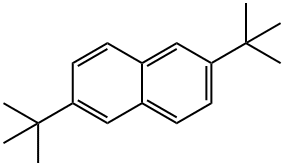2,6-DIISOPROPYLNAPHTHALENE
- CAS NO.:24157-81-1
- Empirical Formula: C16H20
- Molecular Weight: 212.33
- MDL number: MFCD00021648
- EINECS: 246-045-1
- SAFETY DATA SHEET (SDS)
- Update Date: 2025-07-16 09:55:24

What is 2,6-DIISOPROPYLNAPHTHALENE?
Chemical properties
beige crystalline platelets
The Uses of 2,6-DIISOPROPYLNAPHTHALENE
2,6-Diisopropylnaphthalene, is a building block used for the synthesis of more complex compounds. 2,6-Diisopropylnaphthalene (2,6-DIPM) is also used in the manufacturing of pesticide products intended to prevent sprouting of stored potatoes.
Definition
ChEBI: 2,6-diisopropylnaphthalene is a member of the class of napthalenes that is naphthalene which is substituted by an isopropyl group at positions 2 and 6. It is a plant growth regulator which inhibits the sprouting of potatoes during storage. It has a role as a plant growth retardant and an agrochemical.
General Description
Clear yellowish brown liquid with a faint sweet odor.
Air & Water Reactions
Insoluble in water.
Reactivity Profile
Vigorous reactions, sometimes amounting to explosions, can result from the contact between aromatic hydrocarbons, such as 2,6-DIISOPROPYLNAPHTHALENE, and strong oxidizing agents. They can react exothermically with bases and with diazo compounds. Substitution at the benzene nucleus occurs by halogenation (acid catalyst), nitration, sulfonation, and the Friedel-Crafts reaction. Friedel-Crafts acylation of naphthalene using benzoyl chloride, catalyzed by AlCl3, must be conducted above the melting point of the mixture, or the reaction may be violent [Clar, E. et al., Tetrahedron, 1974, 30, 3296].
Health Hazard
Exposure can cause irritation of eyes, nose and throat.
Fire Hazard
Special Hazards of Combustion Products: Irritating vapors and toxic gases, such as carbon dioxide and carbon monoxide, may be formed when involved in fire.
Flammability and Explosibility
Not classified
Properties of 2,6-DIISOPROPYLNAPHTHALENE
| Melting point: | 67-70 °C |
| Boiling point: | 279.3 °C |
| Density | 0.9560 (estimate) |
| vapor pressure | 0.08Pa at 25℃ |
| RTECS | QJ1536000 |
| refractive index | 1.5774 (estimate) |
| Flash point: | 140 °C |
| solubility | Acetonitrile (Slightly), Chloroform (Slightly), Methanol |
| form | powder to crystal |
| color | White to Almost white |
| Specific Gravity | 0.968 |
| Water Solubility | 1mg/L at 25℃ |
| CAS DataBase Reference | 24157-81-1(CAS DataBase Reference) |
| EPA Substance Registry System | 2,6-Diisopropylnaphthalene (24157-81-1) |
Safety information for 2,6-DIISOPROPYLNAPHTHALENE
| Signal word | Warning |
| Pictogram(s) |
 Exclamation Mark Irritant GHS07  Environment GHS09 |
| GHS Hazard Statements |
H302:Acute toxicity,oral H410:Hazardous to the aquatic environment, long-term hazard |
| Precautionary Statement Codes |
P264:Wash hands thoroughly after handling. P264:Wash skin thouroughly after handling. P270:Do not eat, drink or smoke when using this product. P273:Avoid release to the environment. P391:Collect spillage. Hazardous to the aquatic environment P301+P312:IF SWALLOWED: call a POISON CENTER or doctor/physician IF you feel unwell. P501:Dispose of contents/container to..… |
Computed Descriptors for 2,6-DIISOPROPYLNAPHTHALENE
New Products
Indole Methyl Resin tert-butyl 9-methoxy-3-azaspiro[5.5]undecane-3-carboxylate Boc-His(Boc)-OH 2-CTC Resin 4-Chloro-7-tosy1-7Hpyrrolo[2,3-d]pyrimidine 5,7-Dibromo-1H-indole 2,5-dichloro-N-hydroxy-4,6-dimethylpyridine-3-carboximidamide 2,2-Dimethoxy-7-azaspiro[3.5]nonane hydrochloride 4-chloromethyl-5-methyl-1,3-dioxol-2-one (DMDO-Cl) R-2-BENZYLOXY PROPIONIC ACID 1,1’-CARBONYLDIIMIDAZOLE 1,1’-CARBONYLDI (1,2-4 TRIAZOLE) N-METHYL INDAZOLE-3-CARBOXYLIC ACID 4-((2-hydroxyethyl)thio)benzoic acid 1-(TERT-BUTOXYCARBONYL)-2-PYRROLIDINONE Methyl 6-methylnicotinate 3-Pyridineacrylic acid tert-Butyl carbazate TETRAHYDRO-2H-PYRAN-3-OL 2-((4-morpholinophenylamino) (methylthio) methylene) malononitrile 3-(4-morpholinophenylamino)-5-amino-1H-pyrazole-4-carbonitrile 2,4-dihydroxybenzaldehyde 1,3-Diethyl-1,3-Diphenylurea Methyl 2-methylquinoline-6-carboxylateRelated products of tetrahydrofuran








You may like
-
 2,6-Diisopropylnaphthalene CAS 24157-81-1View Details
2,6-Diisopropylnaphthalene CAS 24157-81-1View Details
24157-81-1 -
 Pyridine 99.5% HPLC /UV SpectroscopyView Details
Pyridine 99.5% HPLC /UV SpectroscopyView Details
110-86-1 -
 Guanine , 99%View Details
Guanine , 99%View Details
73-40-5 -
 Piperazine Spot supply, best priceView Details
Piperazine Spot supply, best priceView Details
110-85-0 -
 Dibutyl PhthalateView Details
Dibutyl PhthalateView Details
84-74-2 -
 Imidazole Spot supply, competitive priceView Details
Imidazole Spot supply, competitive priceView Details
288-32-4 -
 Octadecyl 3-(3,5-di-tert-butyl-4-hydroxyphenyl)propionate 98% (GC)View Details
Octadecyl 3-(3,5-di-tert-butyl-4-hydroxyphenyl)propionate 98% (GC)View Details
2082-79-3 -
 Thiourea 99% ARView Details
Thiourea 99% ARView Details
62-56-6
